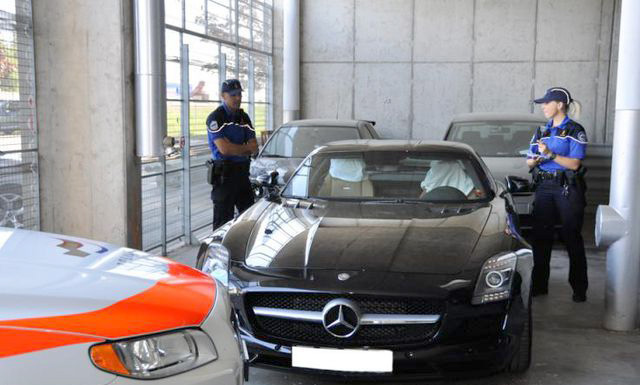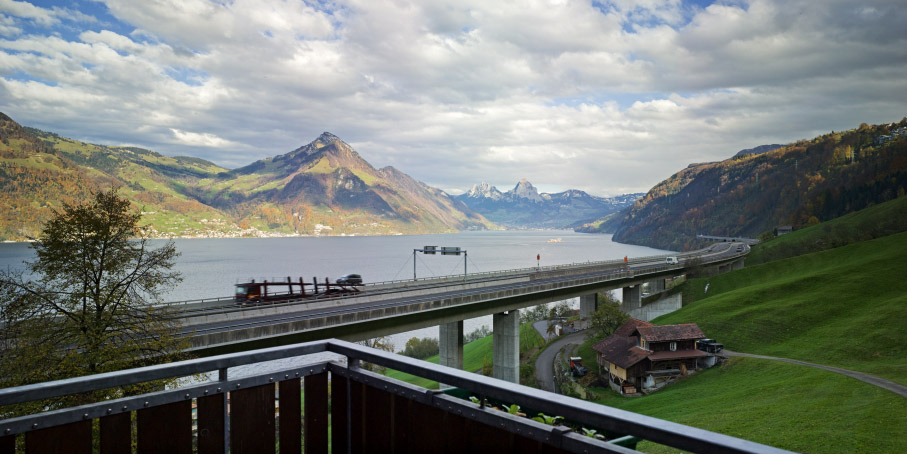Driver faces $1,000,000 speeding fine

A driver who hit headlines around the world for getting clocked in Switzerland at 290km/h (180mph) faces a world record fine of a million francs.
swissinfo.ch looks at the laws and limits on Swiss motorways – arguably the safest in Europe – and talks to the owner of a Porsche about his need for speed.
“A study from the European Transport Safety Council [conducted in 2006, see link] tested all European motorways, and those in Switzerland were the safest,” Thomas Rohrbach, spokesman for the Federal Roads Office, told swissinfo.ch.
The survey found that in Switzerland the number of people killed on motorways decreased by a record 15% a year on average between 2001 and 2006, from 71 to 31.
The authors said this could be down to speed enforcement on motorways becoming a high priority, with the implementation of new speed cameras and increased police checks. In addition, road safety became a big issue in the media during that period.
Rohrbach also thought the 120km/h speed limit played a role.
Swiss safety
Speed limits were only introduced to Swiss motorways in 1973, when the oil crisis saw a temporary limit imposed of 100km/h – as it did in Germany. But whereas the following year Germany lifted the limit, in Switzerland it was raised to 130km/h.
In 1985 this was reduced on a trial basis to 120km/h, which was challenged by pro-130ers in a national referendum in 1989. They lost.
Rohrbach said the lower speed limit resulted in not necessarily fewer accidents but certainly less serious accidents. “Most accidents happen in towns, and the worst are out of towns but not on motorways.”
He added that other important factors were road tunnel safety and the cars themselves. “People are now surviving accidents that 20 years ago they wouldn’t have,” he said.
“Maybe a big difference between Swiss motorways and say German and French ones is that we don’t have long stretches, it’s more local bypasses. Eighty per cent of traffic on Swiss motorways is local traffic, travelling for 15-25 kilometres.”
“Dodgy speedometer”
But all this progress will be lost on the 37-year-old Swede who last week was flashed in canton Vaud exceeding the speed limit by some 170km/h.
His Mercedes SLS AMG – the same make as the safety car at Formula One races – was eventually caught by a new generation speed camera on the A12 between Bern and Lausanne having evaded a number of radars incapable of clocking speeds above 200km/h.
“He needed over half a kilometre to come to a halt,” said Benoît Dumas, spokesman for Fribourg police.
After being formally identified and questioned, he was allowed to leave – minus his car. His excuse was that “the speedometer must have been on the blink”.
A local mechanic told Le Matin newspaper he wasn’t surprised the speedometer wasn’t working. “He obviously disconnected it. It’s an old trick! You can then fool the buyer into believing the car’s been delivered by a truck fresh from the factory.”
According to Le Matin, the car was set to be sold in Germany the same day its driver was stopped.
Gumball
In Switzerland – perhaps surprising for a country that is normally rich-friendly – speeding fines take into account the motorist’s income as well as the speed.
The Swede is now facing the maximum possible penalty of 300 days of fines at CHF3,600 a day – a total of CHF1,080,000 ($1.02 million).
“There are fines for speeding and there are fines for speeding,” Rohrbach said. “There are normal fines of maybe CHF40 or CHF120 if you’re slightly over the limit – there’ll be no further consequences and it doesn’t matter if you’re a millionaire or you have no money. But this guy was going 170km/h too fast. This is a really serious violation of road safety laws and is treated like a crime.”
While this would be the highest speeding fine in the world, the Swede would have been left in the dust of the Koenigsegg CCX that was busted in Texas in 2003 reportedly going a record 390km/h in a 120km/h zone during the San Francisco to Miami Gumball 3000 Rally.
Rohrbach said illegal Gumball Rallies – also known as Cannonball Runs – are rarely a problem in Switzerland.
“A couple of years ago police stopped some Cannonballers in Zurich and on Alpine roads in Graubünden and it’s the same procedure: the cars are confiscated until the fines are paid. But European police have a very good information network, so if [racers] start in say Britain and take the ferry to France, five minutes later the continental police know about it. They then just have to wait to catch them.”
Need for speed
Wanting to get into the mindset of a boy racer – but unable to track down the Swede – swissinfo.ch spoke to the owner of a Porsche Boxster, which has a top speed of 270km/h.
The fortysomething male – who for legal reasons had better remain anonymous – lives in Switzerland and admits to having hit 250km/h, quite legally, in Germany – “the car seemed quite stable at that speed, though it did take a long time to slow down”.
Had he ever broken the speed limit on Swiss motorways? “Yes, though seldom, for a very short time only, and never faster than 160. I’d venture that a majority of Swiss motorway drivers have, at some time, done over 120. I suspect that a lot of the I-never-exceed-120 brigade routinely exceed 50 in towns. In my opinion that’s much more dangerous.”
And how hard is it resisting the temptation to go fast when the car clearly wants to?
“I admit it is hard at times. Speed is certainly exhilarating and possibly addictive. Why else would roller coasters be so popular?”
He also admits that there have been a couple of times when he’s gone much too fast on quiet roads “just because I can”.
“Afterwards I’ve realised that I could have faced a big fine if I’d been caught. But again, this has happened more than once. I’d like to think it won’t happen again, but there’s a suggestion that I’m not completely in control of my need for speed…”
A short stretch of motorway around the Lucerne area in 1955 created Switzerland’s first motorway. For Expo 1964, a motorway was built between Lausanne and Geneva. The Bern-Lenzburg route was inaugurated in 1967.
The Swiss motorway network has a total length of 1,765 km (as of 2008) and, in an area of 41,290 km2, is one of the highest motorway densities in the world.
Every ninth kilometre of motorway runs through a tunnel.
In 2008 the average daily traffic volume on Swiss motorways was almost six million vehicles. There were 519 cars per 1,000 inhabitants.
33,238 drivers lost their licences for speeding in 2008.
According to the Swiss Council for Accident Prevention, 357 people were killed in Swiss road accidents in 2008, and another 25,556 were injured.
Of those, it’s believed that 147 deaths and 5,069 cases of injury were the result of speeding. 1,109 victims were severely injured.
Town/road outside built-up areas/motorway (in km/h)
Switzerland: 50/80/120
Germany: 50/100/no limit
France: 50/90/130 (depends on rain)
Italy: 50/90-110/130
Britain: 32-48/64-113/80-113
US: 24-89/64-121/89-129

In compliance with the JTI standards
More: SWI swissinfo.ch certified by the Journalism Trust Initiative














You can find an overview of ongoing debates with our journalists here . Please join us!
If you want to start a conversation about a topic raised in this article or want to report factual errors, email us at english@swissinfo.ch.